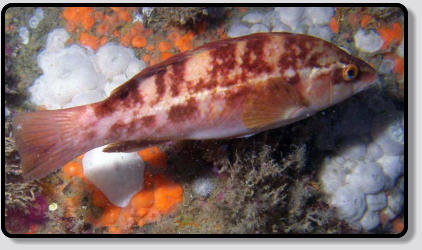Scientific classification
Kingdom:
Phylum:
Chordata
Class:
Actinopterygii
Order:
Perciformes
Family:
Labridae
Genus:
Bodianus
Species:
B. Scrofa
Binomial name (link Wikipedia)




Red Hogfish
Poisson Chien
Roter Schweinfisch
Pejeperro
Varkens Lipvis
Description
Length: up to 80 cm.
Habitat: rocky bottoms.
The barred hogfish, Bodianus scrofa, is a species of wrasse native to the
eastern Atlantic Ocean, where it occurs around the various island groups
from the Azores to Cape Verde. This species occurs on rocky reefs at
depths of 20 to 200 m (66 to 656 ft). It can reach a length of 43 cm (17 in),
though most do not exceed 30 cm (12 in). It is of minor importance to
local commercial fisheries.

Animalia
Scientific classification
Kingdom:
Phylum:
Chordata
Class:
Actinopterygii
Order:
Perciformes
Family:
Labridae
Genus:
Symphodus
Species:
S. Mediteraneus
Binomial name (link Wikipedia)




Atlantic Wrasse
Labre de L’atlantique
Atlantischer Lippfisch
Romero
Atlantische Lipvis
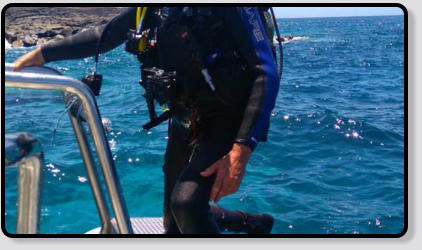
Description
Length: average size 20 cm.
Habitat: rocky bottoms with seaweed.
No further information available on Wikipedia.
Animalia
Scientific classification
Kingdom:
Phylum:
Chordata
Class:
Actinopterygii
Order:
Perciformes
Family:
Labridae
Genus:
Labrus
Species:
L. bergylta
Binomial name (link Wikipedia)




Ballan Wrasse
Labre
Gefleckter Lippfisch
Romero Capitán
Gevlekte lipvis
Description
Length: average size 60 cm.
Habitat: rocky bottoms with seaweed.
The Ballan wrasse (Labrus bergylta) is a species of wrasse native to the northeastern Atlantic Ocean from Norway to Morocco, including the
islands of Madeira, the Azores and the Canary Islands. They can be found at depths from 1 to 50 m (3.3 to 164.0 ft) amongst rocks, seaweed and
reefs. It can grow to 65.9 cm (25.9 in) in total length (though most do not exceed 50 cm (20 in) standard length), and the greatest recorded weight
of this species is 4.4 kg (9.7 lb). All Ballan wrasses are female for their first four to 14 years before a few change into males. Large Ballan wrasses
are almost certainly male.
This species is popular as a food fish in the Orkney Islands and in Galway, although it is not highly regarded as a food fish in much of the UK and
Ireland.
In recent years, it has become a popular catch-and-release target for sport fishermen using light fishing tackle, particularly those employing soft
plastic lures.
It can also be used to clean sea lice from Norwegian farmed salmon;
Animalia
Scientific classification
Kingdom:
Phylum:
Chordata
Class:
Actinopterygii
Order:
Perciformes
Family:
Labridae
Genus:
Thalassoma
Species:
T. Pavo
Binomial name (link Wikipedia)




Ornate Wrasse
Girelle Paon
Meerpfau
Pejeverde
Pauwlipvis
Length: average size 15 cm.
Habitat: rocky and rocky/sandy bottoms.
The ornate wrasse, Thalassoma pavo, is a species of wrasse native to the
eastern Atlantic Ocean from Portugal to Gabon and the oceanic islands
and into the Mediterranean Sea. This species inhabits areas of rocks and
eelgrass in coastal waters at depths from 1 to 150 m (3.3 to 492.1 ft),
though rarely below 50 m (160 ft). It can reach 25 cm (9.8 in) in length,
though most do not exceed 20 cm (7.9 in). This species is of minor
importance to local commercial fisheries, is also popular as a game fish,
and can be found in the aquarium trade.
Description
Animalia
Scientific classification
Kingdom:
Phylum:
Chordata
Class:
Actinopterygii
Order:
Perciformes
Family:
Labridae
Genus:
Coris
Species:
C. Julis
Binomial name (link Wikipedia)




Rainbow Wrasse
Girelle Commune
Meerjunker
Doncella
Regenbooglipvis
Length: average size 15 cm.
Habitat: rocky and rocky/sandy bottoms.
The Mediterranean rainbow wrasse (Coris julis) is a small, colourful fish in
the family Labridae. It can be found in the Mediterranean Sea and in the
northeast Atlantic Ocean from Sweden to Senegal (though it is absent
from the British Isles). Records of this species south from Senegal and
the Cape Verde Islands are actually the closely related Coris atlantica.
It feeds on amphipods, isopods, sea urchins, polychaete, shrimps, and
small gastropods.
These initial-phase individuals (both females and males) can turn into the
larger secondary-phase males.
It is typically found near the shore in places with seagrass or rocks. It is
usually found at depths of 0–60 m (0–197 ft), but occurs as deep as 120
m (390 ft)
Description
Animalia
Scientific classification
Kingdom:
Phylum:
Chordata
Class:
Actinopterygii
Order:
Perciformes
Family:
Labridae
Genus:
Xyrichtys
Species:
X. Novacula
Binomial name (link Wikipedia)




Pearly Razorfish
Rason
Schermesserfisch
Pejepeine
Gestreepte Lipvis
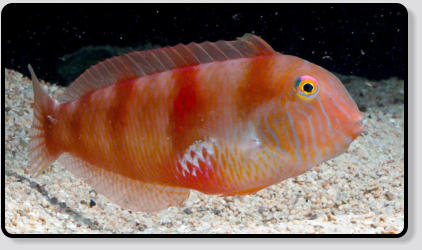
Length: up to 25 cm.
Habitat: sandy bottoms.
Xyrichtys novacula can reach 38 cm (15 in) in total length, though most do not exceed 20 cm (7.9 in). Its body is elongate and very compressed
laterally, head is flattened, with a steep profile and sharp teeth. Its long dorsal fin extends along most of its back, as well as anal, pectoral, and
pelvic fins. It has 9 dorsal spines, 12 dorsal soft rays, 3 anal spines and 12 anal soft rays. This wrasse has a yellow-orange or reddish-pink color
that is darker on the back and lighter on the belly, sometimes marked with green and gray stripes. Head shows vertical narrow light blue lines and
there are scales with brisk reflexes on the abdomen. Upon capture, this fish has been known to turn its mouth and sharp protuding teeth past 90
degrees to either side in relationship to its own body as an attempt to be released from capture.
The pearly razorfish is widespread throughout the western and eastern subtropical and tropical Atlantic Ocean, as well as the Mediterranean
Sea. It inhabits clear, shallow littoral areas with sandy or muddy bottoms, at depths of 1 to 20 m. In winter it migrates to greater depths, up to
90–150 m.
Description
Animalia





Harry van Goor 2016
source: Wikipedia, the free encyclopedia


Categories: Wrasse
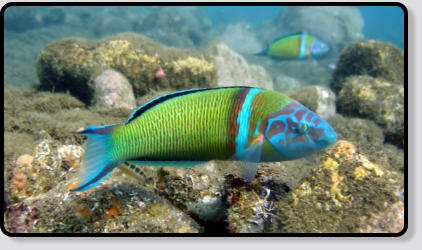
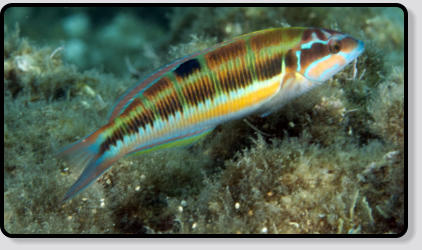
Male
Female


Male
Female
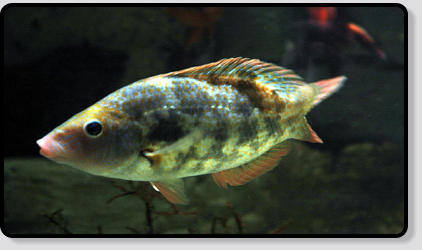
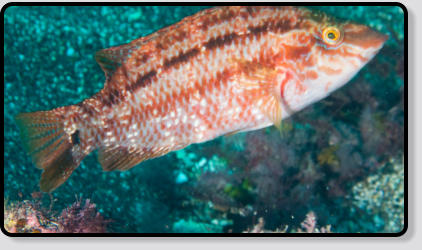
Male
Female
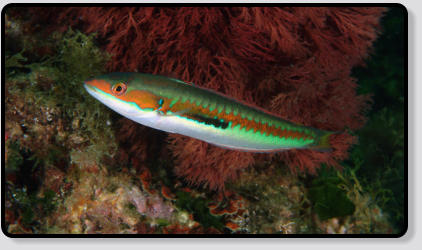
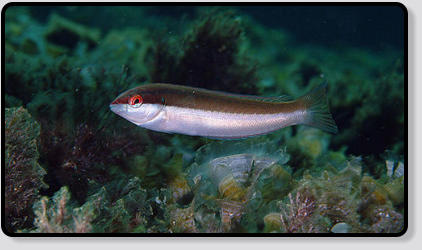
Male
Female
